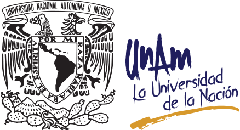
Posters Download Posters in Pdf File
The surface for each poster is 1m wide and 1.30m height
Poster Sessions:
Tuesday 8th August, at the Mathematics Institute, Palapa Chica, 16:40 hrs.
Cesar Augusto Ipanaque Zapata
Maths Science Institute and Computing-University of São Paulo
Minimal CW model for the configuration space of the complex projective space
A model for a topological space is a CW complex homotopy equivalent to it. In the best case, such models are chosen to be minimal, that is, they are chosen such that have the minimum number of cells consistent with its homology, namely, one n cell for each $Z$ summand of $H_n$ and a pair of cells of dimension n and n + 1 for each $Z_k$ summand of $H_n$. In this poster, I will show a minimal CW model for the configuration space of 2-distinct points in the complex projective space.
Hellen Santana
ICMC-USP
The local Euler obstruction and its generalizations
The local Euler obstruction was defined by MacPherson, in [3], as a tool on the study of characteristics classes of singular varieties. In [1], Brasselet, Massey, Parameswaran and Seade present a generalization of this concept, adding informations of an analytic function $f$ with isolated singularity, defined over a singular variety, called the Euler obstruction of a function $f$. More recently, in [2], Dutertre and Grulha have presented another generalization of the local Euler obstruction, called Brasselet Number, which is well defined even if $f$ has non-isolated singularity. In this work, we present some questions about the local Euler obstruction and its generalizations. The goal is to search for relations between the Brasselet Number and other invariants, like the Lê Number, as well as search for formulas to simplify its calculation and then, with those relations, evaluate implications about the topology of functions defined over singular varieties. References [1] J.-P. Brasselet, D. Massey, A. J. Parameswaran, J. Seade, Euler obstruction and defects of functions on singular varieties, Jornal London Math. Soc. (2), 70 (2004). [2] N. Dutertre, N. Grulha, Lê-Greuel type formula for the Euler obstruction and applications, Adv. Math. 251 (2014), p. 127-146. [3] R. D. MacPherson, Chern classes for singular algebraic varieties, Ann. of Math. 100,(1974), 423-432.
MIGUEL ANGEL DE LA ROSA CASTILLO
Universidad Juárez Autónoma de Tabasco
On a Varchenko's Lemma and Higher bilinear forms induced by Grothendieck Duality on the Milnor algebra of an Isolated Hypersurface Singularity
For an isolated hypersurface singularity $f:(\mathbb{C}^{n+1},0)\rightarrow(\mathbb{C},0)$ with Milnor number $\mu$ and good representative $f:(X,0)\rightarrow (\Delta,0)$ canonical $\mu$-dimensional $\mathbb{C}$-bilinear vector spaces are associated: the Milnor algebra, $A_{f}$, and the cohomology of the canonical Milnor fibre, $H$. Indeed, on the algebra $A_f$ one has defined the non-degenerate Grothendieck pairing $res_{f,0}$ which is a symmetric $\mathbb{C}$-bilinear form, and on vanishing cohomology $H$ it is defined a non-degenerate $\mathbb{C}$-bilinear form $bS$, induced by Poincar\'e duality, which is $(-1)^{n+1}$-symmetric on the generalized monodromy eigenspace $H_{1}$ and $(-1)^{n}$-symmetric on the direct sum of generalized monodromy eigenspaces $H_{\neq 1}:=\oplus_{\lambda\neq 1}H_{\lambda}$. On the other hand, there are two nilpotent $\mathbb{C}$-linear maps defined on $A_f$ and $H$ respectively; the first one is the map $\{\mathbf{f}\}$ given by multiplication with $f$, which is $res_{f,0}$-symmetric, and the other one is the $bS$-antisymmetric endomorphism $N$ given by the logarithm of the unipotent part of the monodromy transformation. New bilinear forms can be constructed by composing on the left (or equivalently on the right) with powers of such nilpotent maps: $res_{f,0}(\{\mathbf{f}\}^{j}\bullet,\bullet)$ and $bS(N^{l}\bullet,\bullet)$ for $j,l\geq 1$. These new bilinear forms are called higher bilinear forms on $A_f$ resp. on $H$. In this work, we show a formula which relates the powers $\{\mathbf{f}\}^{j}$ to the powers $N^{l}$. Our proof, which is a consequence of some Varchenko's result obtained in the 1980's, uses the Laurent series (asymptotic) expansions of elements in the Milnor Algebra with respect to the Malgrange-Kashiwara's $cV$-filtration. Finally, when the relation between K. Saito pairing and Grothendiek pairing is considered such a formula provide us with a result that gives an additive expansion for each higher bilinear form on $A_f$ expressed in terms of the higher bilinear forms on $H$ and depending on the asymptotic expansions for the top forms on $A_f$ where these bilinear forms act.
Marcelo Saia
ICMC-Universidade de São Paulo
Geometry and equisingularity of finitely determined map germs from $\mathbb{C}^n$ to $\mathbb{C}^3$, $n >2.$
The study of the geometry of the singularities of map germs is one of the main questions in singularity theory. A key tool to better understanding of the geometry is the description of all strata which appear in the critical locus $\Sigma (f)$, in the discriminant $\Delta (f)$, and in the hypersurface $X(f)$. Moreover, in these sets we can study the numerical invariants that control triviality conditions in families of map germs. In this article, first we investigate the geometry of finitely determined map germs $f: (C^n,0) \to (C^3,0)$ with $n \geq 3$, in the second section we give an explicity description of all strata in these dimensions and, with the aid of a computer system, we show in an explicity way how to compute them in several examples. Concerning the Whitney equisingularity, Gaffney describes the following problem: ``Given a 1-parameter family of map germs $F \colon (C\times {C}^n, (0,0))\to (C \times {C}^p,(0))$, find analytic invariants whose constancy in the family implies the family is Whitney equisingular.'' He shows that for the class of finitely determined map germs of discrete stable type, the Whitney equisingularity of such a family is guaranteed by the invariance of the zero stable types and the polar multiplicities associated to all stable types. A natural question is to find a minimal set of invariants that guarantee the Whitney equisingularity of the family. Gaffney and Vohra in studied map germs from $n$-space to the plane, with $n \geq 3$. In this case they showed that the top dimensional stratum of the inverse image of the discriminant carries all information necessary to determine if the family of map germs is Whitney equisingular, in fact they showed that L\^e numbers of this stratum control all other invariants needed for the Whitney equisingularity. In this work we show that the Whitney equisingularity of $X(f)$ also implies the Whitney equisingularity of the strata in $\Sigma (f)$, and on the other hand, we use the L\^e numbers also for the discriminant $\Delta(f)$, instead of the polar multiplicities, as done in a previous work by the authors, moreover we show that the corank one condition is not needed.
Wednesday 9th August, at the Mathematics Institute, Palapa Chica, 16:40 hrs.
Maria Carolina Zanardo
ICMC - USP
Singularities of Gauss mappings of hypersurfaces in $\mathbb{R}^4$
Following the ideas of T. Banchoff, T. Gaffney and C. McCrory on the book Cusps of Gauss Mappings, we provide in this work different geometrical characterizations for the singularities that may appear in the Gauss map of a generically immersed 3-manifold in $\mathbb{R}^4$.
Mostafa Salarinoghabi
Unifei
The geometry of profiles of surfaces in $\mathbb R^3$
We consider in this work the geometry of the profile of a smooth surface in $\mathbb R^3$ and the way it changes as the direction of projections varies locally in the unit 2-sphere. The key geometric features of the profile are its singularities, inflections and vertices. We locate these on the profile and on its deformations. We also study the deformations of the evolute of the profile.
Pedro Benedini Riul
ICMC/USP
Curvature parabola and asymptotic directions for corank $1$ surfaces in $\mathbb{R}^{4}$
We study the geometry of surfaces in $\mathbb{R}^{4}$ with corank $1$ singularities. At the singular point we define the curvature parabola using the first and second fundamental forms of the surface. R. Mendes and J.J. Nuño-Ballesteros give in \cite{Mendes} a partition in four orbits of all corank $1$ map germs $f:(\mathbb{R}^{2},0)\rightarrow(\mathbb{R}^{4},0)$ (see \cite{Rieger}) acording to their $2$-jets under the action of $\mathcal{A}^{2}$. We show that the curvature parabola distinguishes the four types of corank $1$ singularities only by looking at the type of degeneracy of the parabola. We also show that two corank $1$ $2$-jets $(\mathbb{R}^{2},0)\rightarrow(\mathbb{R}^{4},0)$ are equivalent under the action of the subgroup $\mathcal{R}^{2}\times\mathcal{O}(4)$ iff there exists an isometry between the normal planes preserving the respective curvature parabola. Therefore, the curvature parabola contains all the local second order geometrical information of the surface. Inspired by \cite{Luciana} and \cite{Livro} the definition and some results about asymptotic directions are given.





